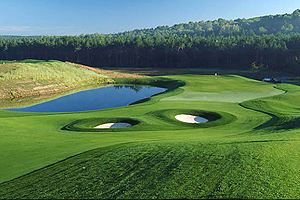Are we golfers too spoiled here in the U.S.? Do you complain when playing a course with slow greens or fast and firm fairways, wishing they’d speed things up a bit while watering and improving those fairways a little more? If so, you may have to reconsider your thinking in today’s environmentally conscious world.
According to the USGA Green Section, a short while back greens at normal member courses were routinely faster than the national championship green speeds of 10 to 20 years ago. Sounds good? Not at the cost it extracts from the environment as well as a golfer’s enjoyment of a round.
Here’s why:
– Fast greens mean more putts and slower play since balls won’t stop rolling and won’t bite, leaving longer, more time-consuming putts.
– Interesting hole locations are lost because portions of the green become unusable; consequently, high traffic pin locations decline faster from overuse.
– Ball marks are slower to heal; close mowing leaves less cushion for ball marks and the grass that is there does not recover as quickly; to illustrate this, one course used white tees to mark each spot of damage from a ball mark. When viewed from afar, the green appeared snow covered…….
– Fast greens cater to a fraction of players, with low handicaps. Average golfers usually cannot negotiate the challenges of fast greens; this adds to frustration levels of an already difficult game.
– Fast greens lead to poor turf. Most greens are mowed to heights of about 1/8 inch or less; this will stress the grass and open it up to moss, winterkill, compaction, drought distress, and disease. To combat this, more chemicals and labor are needed, which works directly against current environmental green practices.
When considering fairway maintenance, there is a simple equation: increasing economic challenges directly impact labor and materials costs; so, excessive watering, fertilizing, and mowing are all too expensive to sustain. That’s why you’ll see continued efforts to reduce playable areas, letting them go ‘green’…or brownish, as it were….. and natural. Of course, isn’t that how it used to be when goats ‘mowed’ the fairways in those early days?
As golfers, we have to cooperate with changing times and realize that the earth does indeed provide us with bountiful resources – though they aren’t unlimited nor immune to damage. You may say, ‘OK, I’m just a golfer. I don’t own a course. How can I help to preserve the course environment?” One way is to follow these practices:
– Be kind to the course: repair ball marks and replace divots to help maintain playability.
– Walk, rather than use a cart, when possible. Walking promotes physical fitness, healthy turf, and a clean environment.
– Look for consistent, true ball roll on greens, rather than speed. Lower mowing heights required for fast greens are at the root of many turf and environmental problems.
– Keep play on the course and stay out of natural areas. Respect designated environmentally sensitive areas and wildlife habitats within the course.
– Use trash and recycling receptacles and encourage others to do the same. If you see trash, don’t pass it up….pick it up!
– Appreciate the nature of the game. Watch for wildlife as you play and support the course’s efforts to provide habitat.
– Educate others about the benefits of environmentally responsible golf course management for the future of the game and the environment.
– Encourage the golf course be an active participant in environmental programs for golf courses, such as those offered by Audubon International.
And speaking of Audubon International, you can also take the Green Golfer Pledge: “I value the nature of the game and accept my responsibility to ensure that golf courses are managed in harmony with the environment.” Then, go to www.golfandenvironment.com. and download their itemized practices as well as learning more of what you personally can do to keep the game in great shape, environmentally.
Another great resource for more information than you can possibly fathom is available from the USGA, considered by many to be the Gold Standard of ‘green’. Check out www.usga.org and click on Course Care.

